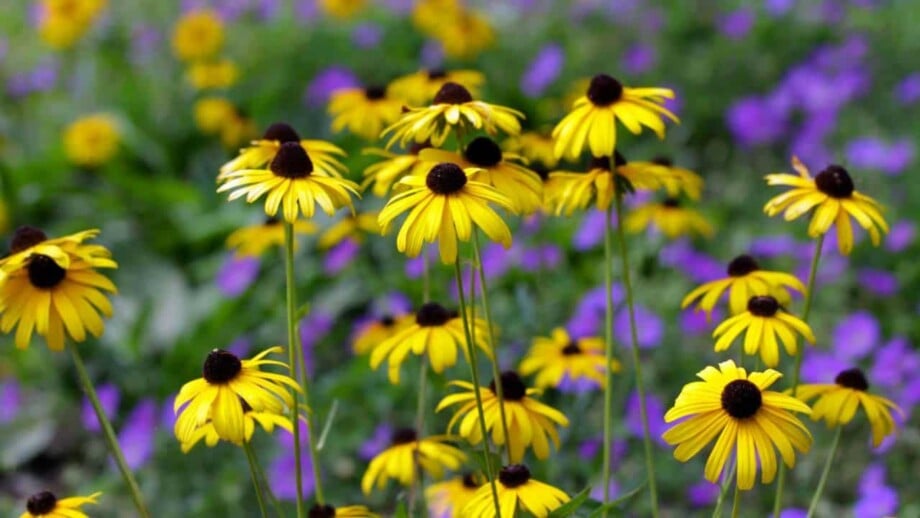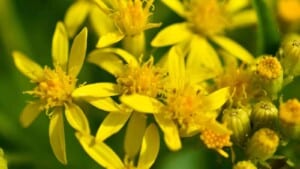Black-eyed susans are cheerful, daisy-like flowers that are beloved by many gardeners for their vibrant yellow petals and dark brown or black centers. This flower is native to the central U.S. and can be spotted in natural areas and near roadsides in the Midwest.
These hardy perennials are known for their bright yellow or orange petals with dark brown centers, which resemble a charming pair of ‘black eyes.’ Its ability to self-seed makes it an excellent choice for abundant wildflower gardens. You can plant your black-eyed Susan plant after spring’s last frost, and it’ll flower in its first summer.
When it comes to planting these radiant flowers, I’ve found that they truly thrive in areas with abundant sunlight. Finding a sunny spot in your garden, whether it’s a flower bed or a container, will ensure their brilliant blooms dazzle all who pass by. Don’t worry too much about the soil type; black-eyed susans are resilient and can adapt to various conditions.
What’s best is that they hold an irresistible allure for wildlife. Their vibrant blooms serve as beacons, attracting bees and butterflies in abundance.
Plus, by leaving the spent flowers on the plants during fall and winter, you create a welcoming haven for finches, providing them with a delightful feast of seeds while adding melodious charm to your outdoor space.
The Rudbeckia genus has a great variety; most of the 25 species are true workhorses with few problems. In the wild, black-eyed Susans (Rudbeckia hirta) are biennial since they germinate in the spring but flower in the second year.
However, if you start their seeds indoors approximately 6 weeks before the last frost date, you’ll have flowers the first year. Some of these plants might come back and bloom for a few more years, which is why they are sometimes called ‘short-lived perennials.’ Other Rudbeckia varieties, such as the Clasping Sunflower (Rudbeckia amplexicaulis) are annuals
In this article, I’ll share my personal experiences, knowledge, and research as a master gardener about planting, growing, and caring for these stunning perennials.

Botanical Name: Rudbeckia hirta
Common Name: Black-eyed Susan, hairy coneflower, Marguerite Jaune, Brown Betty
Family: Asteraceae
Plant Type: Biennial, short-lived perennial
Hardiness Zones: 3 – 9 (USDA)
Sun Exposure: Full sun
Soil Type: Moist, well-drained
Soil pH: 6.8 (Acidic, neutral)
Height: 2 – 3 feet tall
Bloom Time: Summer, fall
Flower Colors: Yellow, orange, red
Native Area: North America
Quick Guide: Planting, Growing & Caring for Black Eyed Susan
- Black Eyed Susans thrive in full sun, although they can tolerate partial shade. For optimal growth and abundant blooms, provide them with at least six hours of direct sunlight each day.
- While they are relatively drought-tolerant, consistent watering is important, especially during dry periods.
- These resilient plants can adapt to various soil types but prefer well-drained soil.
- They generally don’t require heavy feeding. However, you can incorporate compost or well-rotted manure into the soil before planting to provide them with the necessary nutrients.

Black Eyed Susan Plant Care
Black-eyed Susan is a member of the aster family, Asteraceae, and is native to eastern North America. “Black eye” refers to the plant’s dark brown center of its flower head. While some black-eyes Susan species have additional names like Gloriosa daisies, they all belong to the Rudbeckia genus.
These plants can grow 1-3 feet tall with leaves that measure 6 inches. Bees, butterflies, and other pollinators are attracted to this plant for its nectar. As they drink the plant’s nectar, they transport pollen from a plant to another, causing it to grow seeds that can quickly move with the wind.
Black-eyed Susan does well in landscapes, butterfly gardens, borders, or containers when planted in the park. They also are excellent cut flowers. These daisy-like plants are sun worshipers that are tough as nails and can forgive neglect. However, you should avoid overcrowding or watering its leaves as they both can lead to fungal diseases.
Now, watering these beauties is something you should pay attention to. During their initial growing season, remember making a point to water them deeply once a week. This practice encourages robust root development and helps them establish a strong foundation.
As the seasons progressed, you’ll notice their increased tolerance to drought, thanks to their innate adaptability. After that, rainfall combined with occasional watering during dry spells will keep them content.
These daisy-like flowers establish quickly, naturalize well, and require minimal maintenance other than deadheading. Frequent faded flower deadheading keeps the plant blooming. You can let the season’s last flower remain on the plant to create seed heads feeding birds throughout the winter.

Light
You’ll get the best out of your black-eyed Susans if you grow them where they can receive full sun, but they can handle partially shaded areas.
Soil
This plant is not particular about its soil, but it does best in a not nutrient-rich, well-drained soil with a 6.8 pH.
Water
Now, let us discuss the matter of watering. During the initial stages of growth, I have found that a consistent and deep watering routine is crucial. A weekly watering regimen, allowing approximately one inch of water to penetrate the soil, encourages robust root development and establishes a strong foundation for the plants.
As the seasons progress, their inherent resilience enables them to withstand dry spells and be relatively drought tolerant, with occasional supplemental watering being sufficient to keep them content and flourishing.
Temperature and Humidity
The minimum temperature for this plant at night is from 60-65°F, while the average daytime temperature is around 75-85°F.
Black-eyed Susan handles drought and humidity well, but it does need good air circulation to avoid common issues like powdery mildew.
Fertilizer
Black-eyed susans generally don’t require heavy feeding. However, incorporating compost or well-rotted manure into the soil before planting will provide them with the necessary nutrients.

Plus, you can apply a light application of balanced organic fertilizer in early spring to help promote healthy growth and abundant blooms. I recommend using a high bloom-boosting phosphorous one.
Pruning
Black-eyed susans are low-maintenance plants that don’t require extensive pruning. However, to promote bushier growth and more abundant blooms, you can pinch back the stems by a few inches in early summer.
Deadheading, or removing faded flowers, encourages continuous blooming throughout the season and prevents self-seeding, as black-eyed susans can be prolific seed producers.
Types of Black-Eyed Susan
There are several varieties of black-eyed Susan you can choose from. Here are my top favorites that I highly recommend you check out:
- Rudbeckia hirta’ Maya’: This cultivar showcases the classic charm of black-eyed susans with a captivating twist. Its striking golden-yellow petals are adorned with a distinct dark chocolate-brown or black center, creating a dramatic and eye-catching contrast that resembles a marigold plant.
- Rudbeckia hirta ‘Becky’: This particular variety offers a unique twist as a compact dwarf selection, making it an excellent choice for gardens of all sizes.
- Rudbeckia hirta ‘Toto Rustic’: This cultivar embodies the classic charm of black-eyed susans with a twist of rich autumn hues. Its petals display a mesmerizing blend of rustic shades, including deep oranges, golden yellows, and fiery reds.
- Rudbeckia hirta’ Cherry Brandy’: This exceptional variety boasts a stunning display of red-maroon flowers with a dark center, adding a touch of sophistication and allure to any garden.
- Rudbeckia hirta’ Indian Summer’: This remarkable variety showcases large and vibrant yellow flowers, creating a stunning display that will command attention in any garden.
- Rudbeckia hirta’ Cherokee Sunset’: This extraordinary variety is known for its exquisite double and semi-double flowers, showcasing a captivating array of warm shades, including reds and yellows.

Black Eyed Susan Wildlife Value
Black-eyed susans are a favorite among pollinators, such as bees and butterflies, making them an excellent addition to wildlife-friendly gardens.
Their bright blooms also attract birds, particularly goldfinches, who enjoy feasting on their seedheads. Leave the spent flowers on the plants during fall and winter to provide a food source for birds.
What’s best is that they’re simultaneously moderately deer resistant and rabbits rarely bother them either, thanks to the foliage that’s covered in coarse hairs.
How to Plant and Grow Black Eyed Susans
How to Plant Black Eyed Susans
Choose a location that receives full sun or partial shade. Black-eyed susans thrive in bright sunlight, but they can tolerate some shade. Ensure the area has well-drained soil to prevent waterlogging, which can harm the plants.
Before planting, prepare the soil by removing any weeds, rocks, or debris. Black-eyed susans prefer loamy soil, but they are adaptable and can grow in a variety of soil types. If your soil is heavy clay or sandy, you can improve it by incorporating organic matter, such as compost or well-rotted manure, to enhance drainage and fertility.
You can plant black-eyed susans from seeds or as young nursery-grown plants. Both methods can yield beautiful results.
It’s best to plant this perennial in early fall so that they acclimate to their new environment, although they can also be planted mid-spring. These flowers make a great addition to low maintenance landscape.
Plant plenty of black-eyed Susan plants, and you will have ample blossoms to pick from—these flowers beckon pollinators by dozen, such as bees, hummingbirds, and butterflies.
How to Propagate Black Eyed Susans
This plant is a short-lived perennial and might not get old enough to form extensive dense clumps. But if it does, it can be easily divided for propagation in early spring, just as its new growth appears, or when the plant has finished blooming in autumn:
- Using a shovel, lift the plant completely out of the ground.
- Divide the plant in half -or more- using a spade or pruners.
- Replant each section in a new bright location and keep it evenly moist until you notice new growth.
Since this daisy-like flower easily reseeds itself, you might automatically have new plants in your garden next year.

Why Do My Black Eyed Susans Fail to Bloom?
Failed bloom can be caused by a lack of sun. These plants need full sun to thrive properly. Relocate your plant to a different location with filtered sun exposure. It is essential to remember that some perennials may bloom in their second year of life.
Another reason that causes bloom failure is too much nitrogen, which results in lusher foliage but not flowers. Change your fertilizer to a high bloom-boosting phosphorous one.
Common Pests and Plant Diseases for Black Eyed Susans
Though black-eyed susans are generally hardy and resilient, occasional pests and diseases can make an appearance. I’ve encountered a few challenges over the years, including aphids, powdery mildew, and leaf spot.
Vigilance is key; regular inspections allowed me to catch these issues early. At Planet Natural, we all always favor gentle methods like spraying water or utilizing organic pest control options to protect these lovely flowers and maintain the garden’s ecological balance.
You can minimize powdery mildew probabilities by placing your plant where it can receive full sun and good air circulation. It’s one of the most common diseases that affect leaves in humid and warmer temperatures.
Septoria, rust, or angular leaf spots are other fungal diseases that form black spots on the plant’s leaves and stem. You can prevent any of these diseases by avoiding getting the leaves wet when watering. And the only way to treat these fungal diseases is to remove and throw infected leaves away.
Other Flower Guides from Planet Natural:











